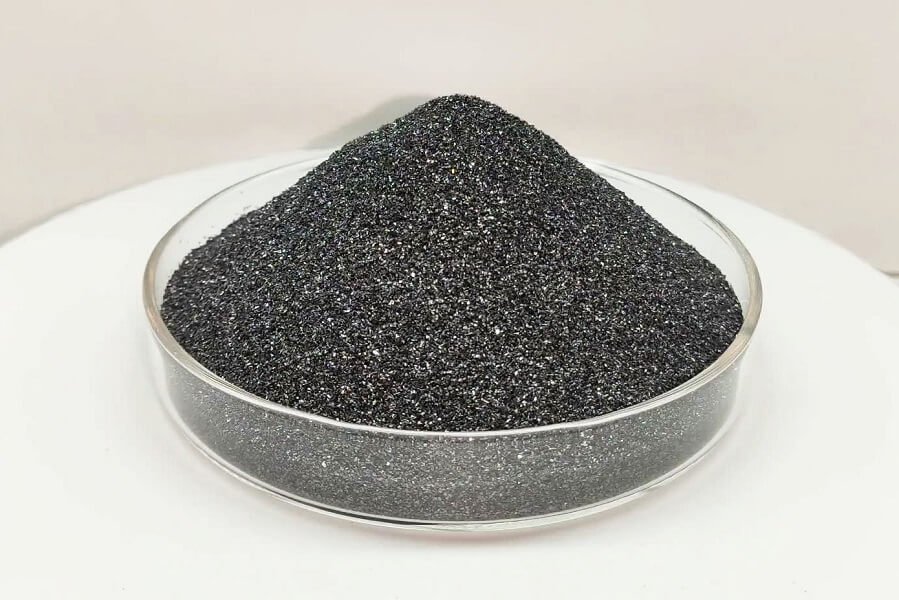Properties of Carborundum Grit
- Robust crystal structure
Silicon carbide is composed of light elements, silicon (Si) and carbon (C). Its basic building block is a crystal of four carbon atoms forming a tetrahedron, covalently bonded to a single silicon atom at the center. SiC also exhibits polymorphism as it exists in different phases and crystalline structures. - High hardness
Silicon carbide has a Mohs hardness rating of 9, making it the hardest available material next to boron carbide (9.5) and diamond (10). This apparent property makes SiC an excellent material choice for mechanical seals, bearings, and cutting tools. - High-temperature resistance
Silicon carbide’s resistance to high temperature and thermal shock is the property that allows SiC to be used in the manufacturing of fire bricks and other refractory materials. The decomposition of silicon carbide starts at 2000°C. - Conductivity
If SiC is purified, its behavior manifests that of an electrical insulator. However, by governing impurities, silicon carbides can exhibit the electrical properties of a semiconductor. For example, introducing varying amounts of aluminum by doping will yield a p-type semiconductor. Typically, an industrial-grade SiC has a purity of about 98 to 99.5%. Common impurities are aluminum, iron, oxygen, and free carbon. - Chemical stability
Silicon carbide is a stable and chemically inert substance with high corrosion resistance even when exposed or boiled in acids (hydrochloric, sulphuric, or hydrofluoric acid) or bases (concentrated sodium hydroxides). It is found to react in chlorine, but only at a temperature of 900°C and above. Silicon carbide will start an oxidation reaction in the air when the temperature is at approximately 850°C to form SiO2.
Carborundum Grit’s Applications
Because of high hardness, high welting point, high thermal conduct rate, high-temperature semi-conductor, and low swell rate, as well as high steady, far-infrared radiation rate, acidproof, alkaliproof, etc. special feature, the products are mainly used in abrasive material, abrasive tool, high-temperature refractory materials, metallurgy oxygen reducing, fine ceramics, alloy, electron, chemical industry and space industry high technical field, especially the silicon carbide fined powder is now researched as a kind of new materials in super-century strategy, therefore has a very wide developing foreground.
Particle size distribution for available grits.
Grading: FEPA Standard
| Grit size | 3% max., | 50% min., | 94% min., | Grit size | 3% max., | 50% min., | 94% min., |
| um | um | um | um | um | um | ||
| F12 | 2000 | N/A | 1400 | F120 | 125 | N/A | 90 |
| F14 | 1700 | N/A | 1180 | F150 | 106 | N/A | 63 |
| F16 | 1400 | N/A | 1000 | F180 | 90 | N/A | 53 |
| F20 | 1180 | N/A | 850 | F220 | 75 | 50.0-56.0 | 45 |
| F24 | 850 | N/A | 600 | F240 | 70 | 42.5-46.5 | 28 |
| F30 | 710 | N/A | 500 | F280 | 59 | 35.0-38.0 | 22 |
| F36 | 600 | N/A | 425 | F320 | 49 | 27.7-30.7 | 16.5 |
| F40 | 500 | N/A | 355 | F360 | 40 | 21.3-24.3 | 12 |
| F46 | 425 | N/A | 300 | F400 | 32 | 16.3-18.3 | 8 |
| F54 | 355 | N/A | 250 | F500 | 25 | 11.8-13.8 | 5 |
| F60 | 300 | N/A | 212 | F600 | 19 | 8.3-10.3 | 3 |
| F70 | 250 | N/A | 180 | F800 | 14 | 5.5-7.5 | 2 |
| F80 | 212 | N/A | 150 | F1000 | 10 | 3.7-5.3 | 1 |
| F90 | 180 | N/A | 125 | F1200 | 7 | 2.5-3.5 | 1 |
| F100 | 150 | N/A | 106 |


Zane (verified owner) –
Good service.